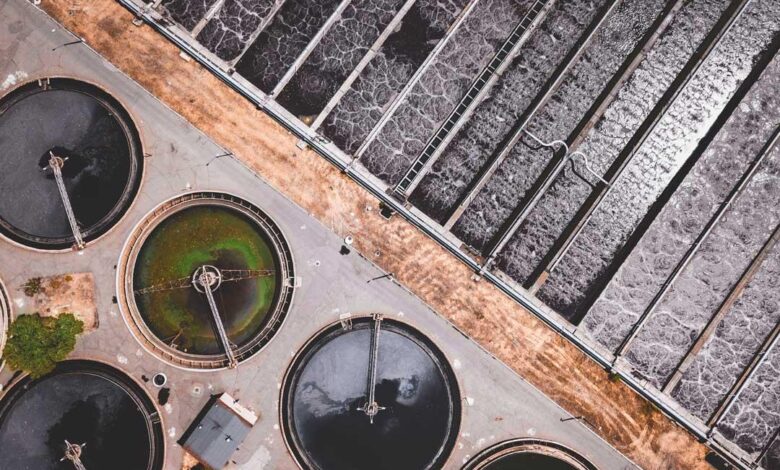Designing a Miniaturized Wastewater Treatment Plant for Micropollutant Degradation

This sponsored article is brought to you by COMSOL.
The 1985 action-adventure TV series MacGyver showcased the life of Angus MacGyver, a secret agent who solved problems using items he had on hand. For example, in one episode, he made a heat shield out of used refrigerator parts. In another, he made a fishing lure with a candy wrapper. More than three decades later, the show still has relevance. The verb MacGyver, to design something in a makeshift or creative way, was added to the Oxford English Dictionary in 2015.
Try putting your MacGyver skills to the test: If you were handed some CDs, what would you make out of them? Reflective wall art, mosaic ornaments, or a wind chime, perhaps? What about a miniaturized water treatment plant?
This is what a team of engineers and researchers are doing at Eden Tech, a company based in Paris, France, that specializes in the development of microfluidics technology. Within their R&D department, Eden Cleantech, they are developing a compact, energy-saving water treatment system to help tackle the growing presence of micropollutants in wastewater. To analyze the performance of their AKVO system (named after the Latin word for water, aqua), which is made from CDs, Eden Tech turned to multiphysics simulation.
Contaminants of Emerging Concern
“There are many ways micropollutants make it into wastewater,” says Wei Zhao, a senior chemical engineer and chief product officer at Eden Tech. The rise of these microscopic chemicals in wastewater worldwide is a result of daily human activities. For instance, when we wash our hands with soap, wipe down our sinks with cleaning supplies, or flush medications out of our bodies, various chemicals are washed down the drain and end up in sewage systems. Some of these chemicals are classified as micropollutants, or contaminants of emerging concern (CECs). In addition to domestic waste, agricultural pollution and industrial waste are also to blame for the rise of micropollutants in our waterways.
Micropollutants are added to the world’s lakes, rivers, and streams every day. Many conventional wastewater treatment plants are not equipped to remove these potentially hazardous chemical residues from wastewater.
Unfortunately, many conventional wastewater treatment plants (WWTP, Figure 1) are not designed to remove these contaminants. Therefore, they are often reintroduced to various bodies of water, including rivers, streams, lakes, and even drinking water. Although the risk they pose to human and environmental health is not fully understood, the increasing number of pollution found in the world’s bodies of water is of concern.
With this growing problem in mind, Eden Tech got to work on developing a solution, thus AKVO was born. Each AKVO CD core is designed to have a diameter of 15 cm and a thickness of 2 mm. One AKVO cartridge is composed of stacked CDs of varying numbers, combined to create a miniaturized factory. One AKVO core treats 0.5 to 2 m3 water/day, which means that an AKVO system composed of 10,000 CDs can treat average municipal needs. This raises the question: How can a device made from CDs decontaminate water?
A Sustainable Wastewater Treatment Method
A single AKVO system (Figure 2) consists of a customizable cartridge filled with stacked CDs that each have a microchannel network inscribed on them. It removes undesirable elements in wastewater, like micropollutants, by circulating the water in its microchannel networks. These networks are energy savvy because they only require a small pump to circulate and clean large volumes of water. The AKVO system’s cartridges can easily be replaced, with Eden Tech taking care of their recycling.
AKVO’s revolutionary design combines photocatalysis and microfluidics into one compact system. Photocatalysis, a type of advanced oxidation process (AOP), is a fast and effective way to remove micropollutants from wastewater. Compared to other AOPs, it is considered safer and more sustainable because it is powered by a light source. During photocatalysis, light is absorbed by photocatalysts that have the ability to create electron-hole pairs, which generate free hydroxyl radicals that are able to react with target pollutants and degrade them. The combination of photocatalysis and microfluidics for the treatment of wastewater has never been done before. “It is a very ambitious project,” said Zhao. “We wanted to develop an innovative method in order to provide an environmentally friendly, efficient way to treat wastewater.” AKVO’s current design did not come easy, as Zhao and his team faced several design challenges along the way.
Overcoming Design Challenges
When in use, a chemical agent (catalyst) and wastewater are dispersed through AKVO’s microchannel walls. The purpose of the catalyst, titanium dioxide in this case, is to react with the micropollutants and help remove them in the process. However, AKVO’s fast flow rate complicates this action. “The big problem is that [AKVO] has microchannels with fast flow rates, and sometimes when we put the chemical agent inside one of the channels’ walls, the micropollutants in the wastewater cannot react efficiently with the agent,” said Zhao. In order to increase the opportunity of contact between the micropollutants and the immobilized chemical agent, Zhao and his team opted to use a staggered herringbone micromixer (SHM) design for AKVO’s microchannel networks (Figure 3).
To analyze the performance of the SHM design to support chemical reactions for micropollutant degradation, Zhao used the COMSOL Multiphysics software.
Simulating Chemical Reactions for Micropollutant Degradation
In his work, Zhao built two different models in COMSOL Multiphysics (Figure 4), named the Explicit Surface Adsorption (ESA) model and the Converted Surface Concentration (CSC) model. Both of these models account for chemical and fluid phenomena.
In both models, Zhao found that AKVO’s SHM structure creates vortices in the flow moving through it, which enables the micropollutants and the chemical agent to have a longer reaction period and enhances the mass transfer between each fluid layer. However, the results of the ESA model displayed that the design purified about 50 percent of the micropollutants under treatment, fewer than what Zhao expected.
Unlike the ESA model (Figure 5), in the CSC model, it is assumed that there is no adsorption limitation. Therefore, as long as a micropollutant arrives at the surface of a catalyst, a reaction happens, which has been discussed in existing literature (Ref. 1). In this model, Zhao analyzed how the design performed for the degradation of six different micropollutants, including gemfibrozil, ciprofloxacin, carbamazepine, clofibric acid, bisphenol A, and acetaminophen (Figure 6). The results of this model were in line with what Zhao expected, with more than 95 percent of the micropollutants being treated.
“We are really satisfied with the results of COMSOL Multiphysics. My next steps will be focused on laboratory testing [of the AKVO prototype]. We are expecting to have our first prototype ready by the beginning of 2022,” said Zhao. The prototype will eventually be tested at hospitals and water treatment stations in the south of France.
Using simulation for this project has helped the Eden Tech team save time and money. Developing a prototype of a microfluidic system, like AKVO, is costly. To imprint microchannel networks on each of AKVO’s CDs, a microchannel photomask is needed. According to Zhao, to fabricate one photomask would cost about €3000 (3500 USD). Therefore, it is very important that they are confident that their system works well prior to its fabrication. “COMSOL Multiphysics has really helped us validate our models and our designs,” said Zhao.
Pioneer in the Treatment of Micropollutants
In 2016, Switzerland introduced legislation mandating that wastewater treatment plants remove micropollutants from wastewater. Their goal? Filter out over 80 percent of micropollutants at more than 100 Swiss WWTPs. Following their lead, many other countries are currently thinking of how they want to handle the growing presence of these contaminants in their waterways. AKVO has the potential to provide a compact, environmentally friendly way to help slow this ongoing problem.
The next time you go to throw out an old CD, or any other household item for that matter, ask yourself: What would MacGyver do? Or, better yet: What would Eden Tech do? You might be holding the building blocks for their next innovative design.
Reference
C. S. Turchi, D. F. Ollis, “Photocatalytic degradation of organic water contaminants: Mechanisms involving hydroxyl radical attack,” Journal of Catalysis, Vol. 122, p. 178, 1990.
MacGyver is a registered trademark of CBS Studios Inc. COMSOL AB and its subsidiaries and products are not affiliated with, endorsed by, sponsored by, or supported by CBS Studios Inc.
IEEE Spectrum




